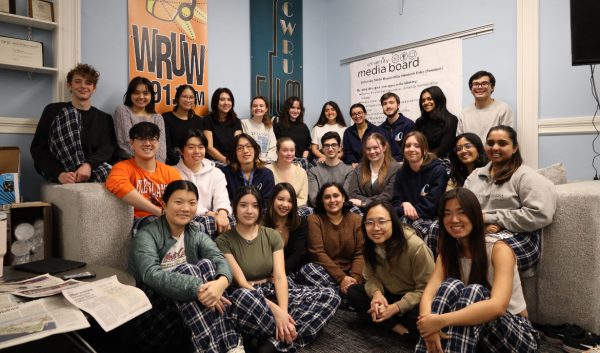Did we pass?
With finals approaching, per Observer tradition, it’s time to turn the tables and hand out this year’s grades.
April 25, 2014
Student Involvement/Initiatives — C
CWRU students have been busy accomplishing great things. We’ve seen a number of newly recognized Undergraduate Student Government organizations including Nursing Students Without Borders, Chabad Student Club, Salsa Dance Club and the Feminist Collective. Attendance at Spot Night and Thwing Tuesdays has been up, and new social events Winterfest and the Yule Ball drew packed houses. Last week’s spring Research ShowCASE saw student participation with notable advances in their respective academic fields, demonstrating the ambition and diligence of the CWRU student spirit. In many ways, we were impressed.
On the other hand, apathy for this institution’s success has still been pervasive among students, especially in terms of running for positions in Student Executive Council member organizations, one of the most crucial student representative groups on campus. Most of USG’s offices went uncontested in their spring elections. On top of that, all positions for the Class Officer Collective (except a freshman presidential spot marred by controversy) only featured one candidate. And media organizations like The Observer are not immune to the problems either. Positions for our own umbrella organization, the University Media Board, also saw only a single candidate run for each post. How can campus governmental groups be truly representative of the student body when the student body doesn’t make an effort to be represented?
Unfortunately, the apathy is not limited only to involvement in student groups; it extends further. While student attendance and turnout at events was up, involvement in dialogue about campus issues was almost nonexistent. Letters to the editor in this paper were sparse, and attendance to the Provost’s Tuition Forum was a whopping 14 students. So even though students were involved with a number of extracurriculars and seemed to be interested in attending events, the lack of passion for their greater situation at CWRU was an equalizer.
University Administration Transparency — D
On a number of issues, when The Observer approached administrators, it was met with resistance and dragging of feet. Admissions numbers were initially withheld when asked for, a columnist was tossed around Adelbert Hall for over six months when he requested a meeting with President Barbara R. Snyder, and it was only after criticism that the university responded to any requests. The Observer maintains its claim that many CWRU administrators practice ‘selective transparency.’ We understand the need for discretion in certain matters, but we also believe that students have a right to know what the administration is doing. After all, with an estimated typical first year budget of $60,125 for the 2014-2015 academic year, students not only have a right to ask questions, but they deserve robust answers. We’re paying. Isn’t clear communication with the group who is cutting the check a no-brainer?
In addition, we felt that The Daily’s handling of Dean Lawrence Mitchell’s resignation from the School of Law was ill-advised, and misleading. The decision to support Mitchell’s tenure as dean and highlight his “gains achieved during [his] leadership,” like “forging educational partnerships with nearly two dozen schools around the globe” and “enhanc[ing] the diversity of the student body” was perplexing to say the least considering that the former dean is embroiled in a lawsuit brought forward by a fellow School of Law Professor Raymond Ku involving the sexual harassment of female coworkers and then a pattern of retaliation against those who reported it.
However, we cannot issue a failing grade with a clear conscience. The Observer eventually did obtain the information it wanted and its senior opinion columnist was granted a meeting with President Snyder. But these ends do not excuse the difficulty it took to attain them.
Construction — C
Case Western Reserve University students are constantly dodging orange barrels, marked off areas and blocked sidewalks.This year is no exception. There are currently five building projects currently in progress on campus: the 89,000-square-foot Tinkham Veale University Center; a medical education building in partnership with Cleveland Clinic; a seven-story, 50,000-square-foot think[box] innovation lab; the Milton and Tamar Maltz Performing Arts Center at The Temple-Tifreth Israel; and the 24,000-square-foot, two-story Wyant Athletic and Wellness Center. Wow, that’s a mouthful.
While we appreciate these efforts and the new infrastructure, are the millions of dollars being spent on these capital improvement really benefiting students? Why isn’t money being spent on things like residence halls or lab improvements, things that would have direct impact improving the student experience? Why is the TVUC called “university” center and not a “student” center? Where does the project’s interest really lie? Are these projects merely feeding egos and serving as something to put on an advertising packet?
The question of construction on campus is a bit sticky. On the one hand, we need to expand and respond to a growing student population, but on the other hand, university resources could have been directed at bettering pre-existing services and rehabbing crumbling structures. Yet the presence of new and innovative buildings on campus is a fun prospect. Only time will tell if CWRU has hit the mark.
University Prestige — A
CWRU kept its 37th spot on US News and World Report’s annual national college ranking list. We were ranked 4th in the Washington Monthly’s guide to colleges that contribute to the national good in 2013. And, on top of being the best university in the state of Ohio, some graduate programs hold high national rankings. These include health law at No. 3, social work at No. 8, and the School of Medicine ranked as 23rd in the nation. But more important than the rankings is the spike in applications, a sign that prospective students are as impressed as our rankers. Applications have risen over 150 percent since 2012, and since the university’s size has remained fairly constant, the acceptance rate has fallen as a result.
In simple terms, CWRU is becoming an increasingly more selective institution.
Additionally, financially, CWRU received $861 million in gifts to its Forward Thinking: The Campaign for Case Western Reserve University initiative as of June 30, 2013, $14 million in gifts from the Board of Trustees. Gifts to the annual fund also set a new all-time record of $10.3 million. This reflects the faith and loyalty of alumni and patrons of the institution alike.
Overall, CWRU has done a superb job maintaining a competitive and forceful presence in the national academic arena and we applaud our university’s efforts in this regard.
Day to Day Student Experience — B
Student life at Case Western Reserve University has seen a good deal of improvement this year. Food is always a bone of contention among undergraduates, but there have been consistent upgrades here. Bon Appétit, CWRU’s food management company, has been taking suggestions from students and responded to a demand for later dining options on the south side by extending the hours of Fribley Commons on Sunday through Thursday until midnight. The food seems like it will always need some improvement, but the fact that some departments are implementing feedback from students is a major step in the right direction.
Transportation also took major steps forward. Along with the arctic temperatures blowing through campus this winter came extra shuttles, including a Cleveland Heights pilot program. Additionally, Greenie routes have been extended to include a Kelvin Smith Library stop.
This year has been an experiment in student life. The university has done a good job in meeting the demands and desires of students in terms of logistics and ease of living. Work is still needed in regards to housing issues, however.
Return On Investment— B
CWRU is expensive and it keeps on getting more expensive with every 3.25 percent tuition increase. This development begs the question, is a CWRU worth its high price?
We’d answer this question with a “yes.” CWRU Class of 2013 graduates made an average of $12,000 more than average college graduating counterparts. CWRU’s $56,400 average starting salary ranked an impressive 68th highest out of thousands of other U.S. universities. CWRU was in similar territory to University of California, Irvine, and ranked above the prestigious John Hopkins University and New York University.
But there is still room to improve. Comparison to CWRU’s typical rival, Carnegie Mellon University, which has a similar, albeit a slightly greater engineering profile, didn’t show much promise. CMU graduates rake in an average of $76,504, close to $20,000 greater than CWRU newly graduate. Yes, CMU students are typically more likely to major in STEM fields, which usually have a greater earning potential so the stats are a bit skewed. But $20,000 is admittedly a large gap, and a concerning one.



















